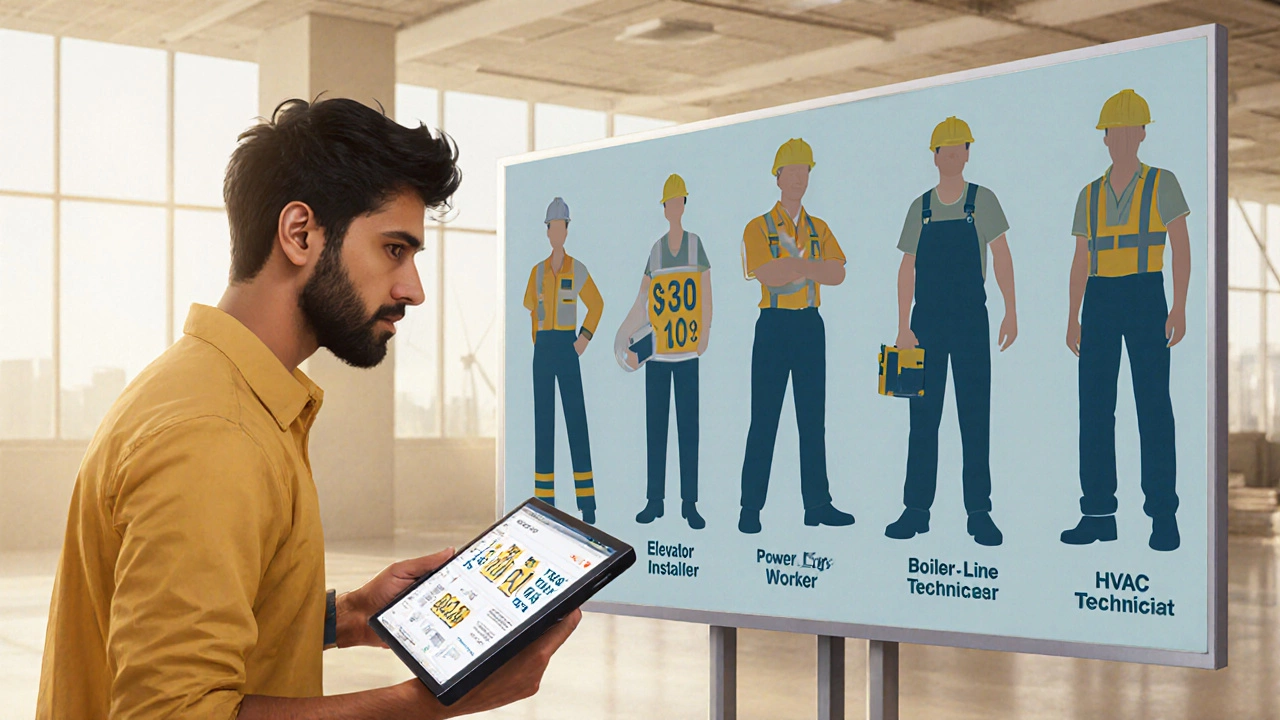Which Trade Pays the Most? A 2025 Guide to High‑Earning Vocational Careers
Trade Earnings Calculator
Earnings Overview
Average Annual Salary
NZ$150,000
Training Duration
4-5 years
Projected Earnings After Experience
NZ$165,000
Job Growth Forecast
8%
Tip: Trades with higher hazard pay and specialized skills tend to offer better long-term earning potential.
Did You Know? Most high-paying trades require 2-5 years of training, not a university degree.
Trade Comparison Table
| Trade | Avg. Salary | Training Time | Growth Rate |
|---|
Trying to decide which trade to learn can feel like a gamble-you want a job that puts food on the table, offers growth, and doesn’t lock you into endless debt. The good news? 2025 data shows several trades that consistently out‑earn the average worker, and most of them require only a few years of training. Below you’ll find the top earners, what drives their pay, and a roadmap to get you started without a four‑year degree.
Key Takeaways
- The five highest‑paying trades in 2025 are elevator installing, power‑line work, boilermaking, HVAC service, and wind‑turbine tech.
- Average salaries range from NZ$90,000 to over NZ$150,000, with many positions offering overtime and hazard pay.
- Most high‑paying trades need 2‑5 years of apprenticeship or certificate training, not a university degree.
- Job growth is strongest in renewable‑energy and infrastructure sectors, keeping demand steady for years to come.
- Choosing the right trade involves matching your interests, physical abilities, and local market demand.
Why Some Trades Out‑Earn Others
Several factors push certain trades into the top‑earning bracket:
- Risk and hazard pay - Jobs that involve heights, electricity, or confined spaces often include premium compensation.
- Specialized skill scarcity - Fewer qualified workers mean higher wages for those who complete the training.
- Industry growth - Renewable energy, data‑center construction, and infrastructure upgrades create a surge in demand.
- Union contracts - Many high‑paying trades are unionised, guaranteeing regular wage bumps and benefits.
Top High‑Paying Trades in 2025
Below are the eight trades that command the most dollars per year in New Zealand and comparable markets like Australia and the United States. Each entry starts with a concise definition wrapped in Elevator installer and repairer style markup, followed by salary, training length, and growth outlook.
| Trade | Average NZ Salary | Typical Training (years) | Job Growth (2025‑2030) | Main Hazard Pay |
|---|---|---|---|---|
| Elevator installer and repairer | $150,000 | 4‑5 (apprenticeship + certification) | 8% | Fall‑height premium |
| Power line installer and repairer | $140,000 | 3‑4 | 10% | Electrical hazard bonus |
| Boilermaker | $130,000 | 3‑4 | 6% | Heavy‑equipment premium |
| HVAC technician | $100,000 | 2‑3 | 7% | Emergency‑call overtime |
| Wind‑turbine technician | $105,000 | 2‑3 | 12% | Remote‑site allowance |
| Industrial machinery mechanic | $95,000 | 2‑3 | 5% | Equipment‑maintenance bonus |
| Plumber | $92,000 | 3‑4 | 4% | After‑hours call‑out |
| Electrician | $95,000 | 3‑5 | 6% | High‑voltage premium |

How to Choose the Right Trade for You
Not every high‑paying trade suits every personality. Ask yourself these quick questions before you sign up for an apprenticeship:
- Do you enjoy working outdoors or at heights? If yes, trades like elevator or power‑line work might click.
- Can you handle irregular hours and on‑call emergencies? HVAC and plumbing often require evenings and weekends.
- Are you comfortable with physically demanding tasks? Boilermaking and wind‑turbine tech are stamina‑heavy.
- Do you prefer a steady paycheck without overtime spikes? Electrician roles in commercial settings usually have predictable schedules.
Match your answers with the job‑growth figures in the table. A trade that aligns with your lifestyle and has a 10%+ growth forecast is a safe bet for long‑term earnings.
Pathways to Certification
All the trades above share a common route: apprenticeship + certification. Here’s a typical timeline you can expect:
- Year0‑1: Enrol in a recognised trade school or TAE (Technical and Apprenticeship Education) program. You’ll study safety, core theory, and basic tools.
- Year1‑3/4: On‑the‑job apprenticeship. You earn a wage while a journeyperson mentors you. Most apprentices earn 50‑70% of the journeyperson rate at first, rising each year.
- Year3/4: Write the competency assessment or national licensing exam. Pass and you become a fully qualified tradesperson.
Many training providers now blend online theory with in‑person labs, letting you start learning while still working a part‑time job.
Financial Considerations and Support
One fear of trade training is cost. In New Zealand, the government’s Trades Training Incentive Scheme reimburses up to NZ$3,000 for eligible apprentices. Additionally, most employers cover a portion of tools and safety gear. If you’re still worried about cash flow, look into:
- Apprenticeship wages (average NZ$30‑45k per year, increasing as you progress).
- Student‑loan interest‑free deferments for vocational courses.
- Union scholarships that target high‑demand trades like power‑line work.

Pros and Cons of High‑Paying Trades
| Pros | Cons |
|---|---|
| Earn above‑average salaries early in your career. | Physical strain and occasional hazardous conditions. |
| Apprenticeship wages offset tuition costs. | Irregular hours; on‑call duties can disrupt personal life. |
| Strong job growth, especially in green‑energy sectors. | Requirement to stay current with safety certifications. |
| Clear career ladder - journeyperson → foreman → manager. | Geographic limitation: some trades cluster in urban or industrial areas. |
Real‑World Success Stories
James, a 28‑year‑old from Hamilton, quit his retail job after a year and entered a power‑line apprenticeship. Within three years he was earning $85,000, and after gaining his licence he secured a contract that pushes his earnings over $140,000, plus overtime. His secret? He leveraged the government’s training incentive and chose an employer that covered his safety‑gear costs.
Sarah, a former high‑school physics teacher, switched to wind‑turbine technology because she loved renewable energy. The two‑year certification program opened doors to remote sites with $110,000 salaries and a travel allowance that covers living costs. She now mentors new apprentices, adding a modest stipend to her base pay.
Next Steps: Turning Interest into Income
- Identify the trade that matches your lifestyle using the quick quiz above.
- Research local training providers - check their accreditation with NZQA.
- Apply for apprenticeship positions early; many firms start hiring in March for the fiscal year.
- Secure any financial assistance (government schemes, union scholarships).
- Begin your apprenticeship, stay on top of safety certifications, and track your earnings growth.
Remember, the most rewarding trade isn’t just the one that pays the most-it’s the one you can see yourself doing for years without burning out.
Frequently Asked Questions
Which trade has the fastest salary growth?
Wind‑turbine technicians see the steepest rise, with projected salary increases of 12% between 2025 and 2030, driven by New Zealand’s renewable‑energy push.
Do I need a university degree to become an electrician?
No. A 3‑5‑year apprenticeship plus a national licence is sufficient. Some employers may prefer a trade‑school certificate, but a degree is not required.
Can I start an apprenticeship without any prior experience?
Absolutely. Most apprentices start as high‑school graduates. Your aptitude for hands‑on work and willingness to learn are the key factors.
What safety gear is required for high‑risk trades?
Typical gear includes hard hats, fall‑arrest harnesses, insulated gloves, steel‑toe boots, and hearing protection. Employers often supply the basics, but you may need to purchase personal items.
Is there a demand for these trades outside of Auckland?
Yes. Infrastructure projects in Wellington, Christchurch, and regional towns drive demand for electricians, plumbers, and wind‑turbine technicians alike.





